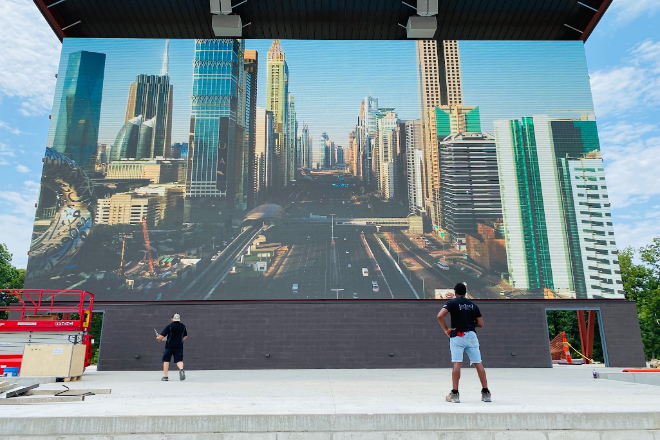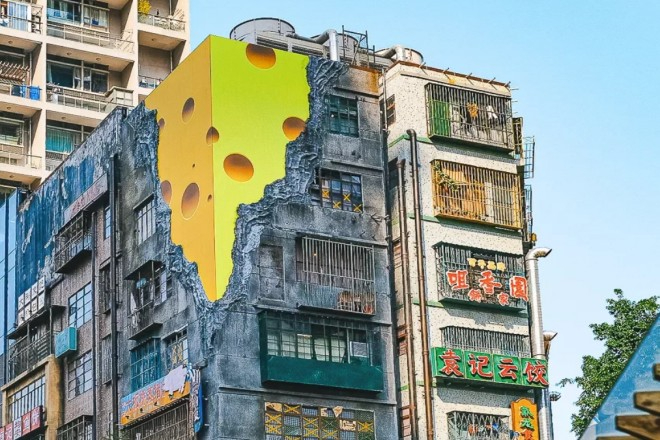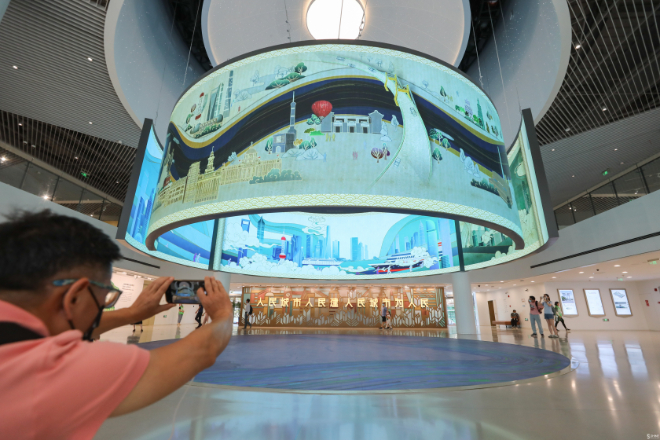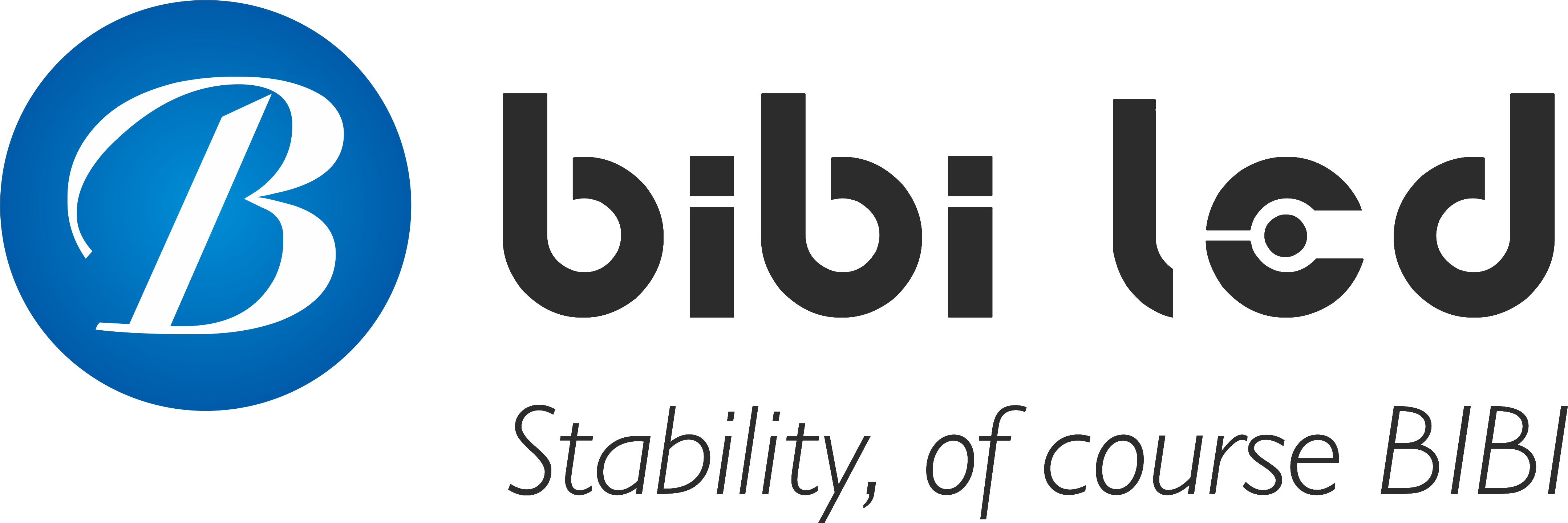介绍

Have you ever thought that walking into an urban planning 博物馆 can help you understand the past, present, and future of the city, as if you were watching a movie?
In this era of rapid development of informatization and intelligence, LED显示屏 are no longer just a simple playback tool but an indispensable “eye of wisdom” in the urban planning museum.
It not only makes the display more vivid but also greatly enhances the interactivity and immersion, bringing visitors a brand-new urban experience.
目录
1. What are the functions and display requirements of the urban planning museum?

The urban planning museum is like a “city growth diary”, recording the changes of the city from ancient times to the present.
For example, those ancient buildings and major events that have happened are displayed in interesting ways such as photos, models, and videos, allowing visitors to see how the city has become what it is now step by step, just like watching a movie.
The urban planning museum will “draw” the current situation of the city, such as administrative divisions, infrastructure distribution, and functional area divisions.
Through sandbox models, electronic maps, graphic display boards, etc., the current status of the city’s transportation network, public service facilities, industrial layout, etc., is intuitively presented so that visitors can have a clear understanding of the city’s existing pattern.
For example, how the city’s roads are distributed, where there are schools, 医院, 购物广场, etc., can all be seen at a glance.
The Urban Planning Museum also needs to “draw” the future of the city, showing the future development direction, planning projects, expected goals, etc.
Through dynamic models, multimedia demonstrations, interactive experiences and other display methods, the blueprint of the city’s future is vividly presented, allowing visitors to experience the future city life in advance and stimulate their expectations and confidence in the city’s future.
The Urban Planning Museum cannot just “talk to itself” but also interact with visitors.
By setting up interactive experience areas, using advanced technologies such as virtual reality (VR), augmented reality (AR), and intelligent perception.
Allow visitors to personally participate in the simulation process of urban planning, such as designing a street and planning a park, to enhance their sense of participation and experience.
At the same time, lectures, seminars, exhibitions, and other activities will be held to explain the knowledge of urban planning to everyone so that everyone can better understand urban planning and improve public awareness and participation.
5.1). Inheriting urban culture:
The Urban Planning Museum is also a display window for urban culture. By displaying the city’s history, culture, folk customs, etc., it allows everyone to better understand the city’s cultural heritage, inherit and promote urban culture.
5.2). Education and training:
The Urban Planning Museum can be a place to learn urban planning knowledge, provide a place for learning and training for students, professionals, etc., carry out courses, lectures, and practical activities related to urban planning, and cultivate the public’s urban planning awareness and professional talents.
5.3). Leisure and entertainment:
Visiting the Urban Planning Museum can also be a way of leisure. There is a leisure area in the museum, so that visitors can rest and communicate after visiting, and enhance the visiting experience.
2. The application of LED display screens in the Urban Planning Museum to display the future planning of the city
1). Animation “plays” the future city
Imagine what the future city will look like. The LED display is like a magical “brush” that “paints” the future city through animation.
For example, how new high-rise buildings are built bit by bit, how new subway lines run, and how those beautiful parks and green spaces are arranged can all be seen in the animation.
Visitors feel the future of the city in advance, just like watching a science fiction movie, and find it particularly interesting.
2). Look at the “progress bar” of the planning project
Sometimes, we want to know what the project under construction in the city has reached. The LED display is like a “progress bar” that can clearly show the latest situation of the project.
For example, a large-scale construction project has been completed halfway, and what is being done now can be displayed through dynamic charts and real-time data.
At the same time, you can also see the final renderings of the project so that everyone can feel the future results in advance and have a better understanding of the situation.
3). Talk about the “general direction” of the city’s future
How will the city develop in the future? The LED display can tell everyone in various ways. For example, use text, charts, videos, etc., to clearly explain the city’s development concept and goals.
For example, sustainable development will tell you how to save energy and protect the environment; 智慧城市 construction will introduce high-tech things such as smart transportation and smart energy management.
Through these contents, visitors can better understand the future path of the city and have more confidence in the development of the city.
In general, the application of LED display screens in the Urban Planning Museum is like a “time machine,” allowing everyone to see the future city in advance and also allowing everyone to understand the city’s development plan more clearly, feeling like participating in the future construction of the city.
3. The application of LED display screens in the publicity and education of the Urban Planning Museum

1). Playing urban planning promotional films:
Imagine walking into the Urban Planning Museum, and the big screen in front of you suddenly lights up and starts playing a wonderful promotional film.
This film is a wonderful movie, clearly showing the significance, goals, and achievements of urban planning.
For example, it shows the new look of the city, the new transportation system, the new park, and the happy life scenes of the residents so that visitors can understand how important urban planning is at once.
This vivid and vivid way is much more interesting than a simple text introduction, which can grab everyone’s attention at once and make everyone more interested in urban planning.
2). Display urban planning regulations and policies:
There are many regulations and policies for urban planning. These contents may sound a bit boring, but LED display screens can make them easy to understand. The complex regulations and policies are displayed one by one through text, charts, and even animations.
For example, charts can be used to show the planning requirements of different areas, and animations can be used to explain some complex policy clauses.
In this way, visitors can not only easily access these contents but also better understand and know what rules they should abide by in urban life and how to participate in urban planning, which enhances everyone’s legal awareness and sense of participation.
3). Hold interactive lectures and training:
The Urban Planning Museum will also hold various lectures and trainings, and the LED display screen is a “good helper” for these activities.
Explanators can use the display screen to display various cases, pictures, and videos to make the explanation content richer and more intuitive.
For example, when explaining urban traffic planning, traffic cases in different cities can be displayed so that everyone can intuitively see the different results of good and bad planning.
This interactive method can not only improve the effect of lectures and training but also allow everyone to learn a lot of useful knowledge in a relaxed and pleasant atmosphere, making learning no longer boring.
In general, LED display screens are like “super assistants” in the publicity and education of urban planning museums, making complex planning content vivid and interesting, and making boring legal policies easy to understand.
4. Application of LED display screens in the interactive experience of the Urban Planning Museum
1). Touch interactive display:
Imagine that you walk into the Urban Planning Museum and see an extra-large touch screen, like a huge tablet. You can’t help but walk up and touch the screen gently and find that you can zoom in or out of the map at will to see the changes near your home.
For example, if you want to know where the new park is or how the future subway line will go, you can find the answer with just a click.
Moreover, this touch screen allows you to choose different display content yourself.
For example, you can switch to the display of historical buildings to see how the ancient buildings in the old city have become what they are now step by step, or look at the future city night view and feel the future prosperity.
This hands-on operation method is not only fun but also allows you to have a deeper understanding of urban planning, making the visit more interesting and participatory.
2). Combination of virtual reality and augmented reality:
LED display screens can also “join hands” with virtual reality (VR) and augmented reality (AR) technology to bring visitors a super cool experience.
For example, by wearing VR glasses, you can instantly “travel” to the city of the future, walk on the newly built streets, and feel the magnificence of high-rise buildings and the beauty of new parks.
You can see the future transportation system, such as driverless cars shuttling on the road or flying taxis in the sky, as if you are in a science fiction movie.
Or, you can use AR technology to overlay planning information on real scenes.
For example, you are standing in an empty square, and through the camera of your mobile phone or tablet, the screen will show the planning map of the square in the future, as if the future building has really appeared in front of you.
This immersive experience makes you feel as if you are really in the city of the future and feel the charm of urban planning.
3). Multi-screen interaction and data sharing:
In the Urban Planning Museum, multiple LED display screens can be connected through the network to achieve multi-screen interaction.
For example, the planning information you see on one screen can be easily switched to another screen or shared with other visitors.
You can discuss a planning project with your friends, look at the content on different screens, and exchange ideas with each other.
You can also interact with the staff in real-time. For example, you can ask them questions or discuss a planning project together. The staff can show more details through the screen or explain some complex planning content.
This multi-screen interactive method not only makes the display more flexible but also allows everyone to participate and discuss the development of the city together, making the visit an interesting interactive experience.
5. Advantages of LED display screens in the operation and maintenance of urban planning museums

LED display screens are like the “durable king” in urban planning museums. Its lifespan is particularly long, unlike some equipment that has to be replaced after a short time.
Moreover, it is particularly energy-saving and has low power consumption, unlike those “power tigers” that consume a lot of electricity after a while.
In this way, the urban planning museum does not need to frequently replace equipment, nor does it need to frequently find people to repair it, which greatly reduces maintenance costs.
For long-term operations, this is a considerable economic advantage! For example, some traditional display screens may need to be replaced after two or three years, while LED display screens can be used for five or six years or even longer, and the money saved in the meantime is not a small amount.
LED display screens are particularly reliable, just like a diligent “workaholic,” and can run stably for a long time.
No matter how complex the display content is, it can be displayed steadily and will not easily fail. This is very important for the Urban Planning Museum because visitors may come at any time.
If the equipment suddenly breaks down, it will not only affect the visitor’s experience but also damage the image of the Urban Planning Museum.
The high stability and reliability of the LED display screen can ensure that the display content is always online so that visitors can see the wonderful display content at any time without worrying about “halfway shutdown”.
LED display screens also have a super convenient feature. That is, content update and management are particularly simple.
As long as the network connection and control system are connected, the staff can modify and adjust the display content anytime and anywhere.
For example, if there is new progress in urban planning or new policies need to be displayed, the staff can easily update the content by just moving their fingers on the computer without having to go to the site to operate.
Moreover, the update speed is very fast, almost “updated in seconds”, which can timely reflect the latest developments and information in urban planning.
In this way, the display content of the Urban Planning Museum can always remain fresh so that visitors can see the latest things every time they come.
In general, the LED display screen is like a “super assistant” in the operation and maintenance of the Urban Planning Museum.
It can not only save money and worry but also ensure the stability of the display effect, making content updates easy and timely. With it, the operation of the Urban Planning Museum is more efficient and convenient.
6. Conclusion
The application of LED display screens in the Urban Planning Museum is changing the way cities are displayed.
It not only improves the communication efficiency and visiting experience but also creates a real connection between the city’s history, culture, development blueprint, and the public.
From information display to interactive experience, from education communication to efficient management, LED display screens are becoming an important tool to help modernize and intelligentize urban planning work.
最后,如果你想了解更多关于LED显示屏的信息, 请与我们联系。
